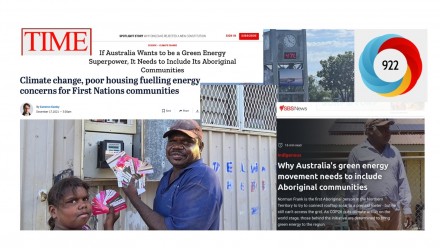Energy insecurity during temperature extremes in remote Australia
Project overview
This project examines pathways to Indigenous benefit in the energy transition, beginning by grounding understanding in drivers of contemporary experiences of energy insecurity and considering opportunities for benefit across scales of clean energy development, from small to large.
This community identified and partnered research builds upon preliminary investigations by researchers at the Tangentyere Research Hub in Mparntwe (Alice Springs) and Julalikari Aboriginal Corporation in Tennant Creek (Jurnkkurakurr).
Academic analysis led by Dr Thomas Longden of ANU Crawford School of Economics, Dr Simon Quilty of ANU School of Population Health, Bradley Riley from ANU Centre for Aboriginal Economic Policy Research and Dr Lee White from ANU School of Regulation and Global Governance, together with partners in Australia’s Northern Territory.
Figure 1 – Temperatures in the NT compared to the rest of Australia
a) Highest minimum temperature b) Lowest minimum temperature


Figure 2 - Impact of temperature on disconnections and electricity use
a) Probability of same-day disconnection by temperature

b) Daily electricity use by temperature

Remote communities experience some of the most extreme temperatures in Australia. In Australia’s Northern Territory, most remote living Indigenous households are provided with or elect to use prepayment electricity meters. This payment method is associated with high disconnection rates, as electricity used to sustain safe indoor temperatures can rapidly deplete available means, frequently resulting in disconnection with little warning. At these moments, households lose access to other essential services that uninterrupted access to electricity provides, such as food storage, washing, cooking and lighting. Research in this project finds that more extreme temperatures are correlated with greater likelihood of disconnection due to non-payment. That is, electricity access is frequently compromised at those times when it is needed the most.
Disconnection as an indicator of energy insecurity
This analysis used daily smart-meter data from 3,300 households across 28 remote communities in Australia’s Northern Territory to identify the incidence of disconnection events. These smart-meter data were matched with daily temperature observations from the closest weather station using data from the Australian Bureau of Meteorology.
Outputs resulting from the project
Research publications
Longden, T., Quilty, S., Riley, B., White, L.V., Klerck, M., Napaltjari-Davis, V., Jupurrurla-Frank, N. et al. Energy insecurity during temperature extremes in remote Australia. Nature Energy 7, 43–54 (2022).
Longden, T., Quilty, S., Riley, B. et al. Temperature extremes exacerbate energy insecurity for Indigenous communities in remote Australia. Nature Energy 7, 11–12 (2022).
Government submissions
Off-grid Protection Framework Review, 30 March 2022
Draft decision - Repeal and replacement of the Code of Conduct for the Supply of Electricity to Small Use Customers 2018, 11 Feburary 2022
Submission in Response to the Electricity Retail Supply Code Review, 2 August 2021
Submission in response to Prepayment Meter System Code Review, 29 April 2021
Policy brief
Longden, T., Quilty, S., Riley, B. et al. Temperature extremes exacerbate energy insecurity for Indigenous communities in remote Australia. Nature Energy 7, 11–12 (2022).
Further research
There is ongoing work associated with this project to map the disparities in regulatory protections across Australia, in the project Bringing to light regulatory disparities for electricity access and services across Australia (White et al 2022).














